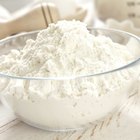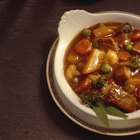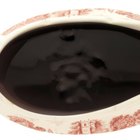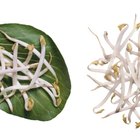
Sauces are at the heart of many dishes, such as macaroni and cheese and chicken pot pie, and they are used as toppings for desserts and savory dishes. A velvety blend of flour and liquid, the sauce gives the dish substance and structure and binds its ingredients together. The amount of flour used to make a sauce determines its thickness and what purpose it is best suited for.
Before or After
Flour can be used to thicken a sauce at the start of a recipe or at the end. When used as a starting point, it is blended with melted butter and cooked briefly to eliminate its raw taste. Called a roux, the mixture needs the addition of a liquid in the form of water, milk or broth to stabilize and thicken it, providing a base to which you can add other ingredients and flavorings. When making a roux, use equal parts of flour and butter or another type of fat and add the liquids proportionately. One tablespoon of flour and 1 tablespoon of butter is enough to thicken 1 cup of liquid and produces a thick yet pourable sauce.
Thick or Thin
The amount of flour used in the roux determines how thick the sauce will be depending upon how much liquid is added. To make a thicker sauce, use 2 tablespoons of flour to 2 tablespoons of butter, and add 1 to 1 1/2 cups liquid. The same ratio applies to finishing a sauce or gravy with a flour thickener. Plan on 1 tablespoon of flour for every cup of liquid you wish to thicken, and blend it first with some of that liquid in order to incorporate it without creating lumps.
Sneak Attack
If your sauce isn't thick enough and you don't want to add anymore liquid to it, try adding a blend of equal parts softened butter and flour. The butter and flour are blended into a thick, dough-like paste called beurre manie that can be added in tiny amounts to a simmering pot of stew or soup. Stir the soup or stew constantly after each addition of beurre manie until it reaches the consistency you like.
The Thickening Process
Flour is composed of thousands of starch molecules that absorb whatever liquid they are exposed to. When heated, the waterlogged molecules expand and start to release their starch into the surrounding liquid, which explains why the thickening effect happens very quickly. It's always best to add a flour-and-liquid mixture slowly into hot liquids, as adding too much at once can thicken it too much. Cook the sauce a bit longer until you are sure it won't thicken anymore before adding more flour.
Related Articles

Can You Use Matzo Flour to Thicken ...

How to Substitute Potato Starch for ...

How to Thicken a Watery Beef Stew

How to Use Millet Flour

How Do I Thicken Curry?

How to Make Creamy Alfredo Sauce With ...

How to Make a Cream Sauce With ...

Can You Deep-Fry Chicken Wings With ...

What If Beef Bourguignon Sauce Does Not ...

How to Use Pectin to Thicken Sauces

Can You Use Flour to Thicken Chili?

How to Substitute Cornstarch for ...

How to Make Cherry Bomb Shots

How to Get Half & Half to Thicken

How to Replace Flour With Oat Flour

Can I Use Pancake Mix to Thicken Sauce?

How to Make Gravy From Gravy Mix

Do You Use Flour or Corn Starch to ...

What Can I Use to Thicken a Cream Sauce?

How to cook bean sprouts
References
Writer Bio
Rachel Lovejoy has been writing professionally since 1990 and currently writes a weekly column entitled "From the Urban Wilderness" for the Journal Tribune in Biddeford, Maine, as well as short novellas for Amazon Kindle. Lovejoy graduated from the University of Southern Maine in 1996 with a Bachelor of Arts in English.
Photo Credits
Eising/Photodisc/Getty Images